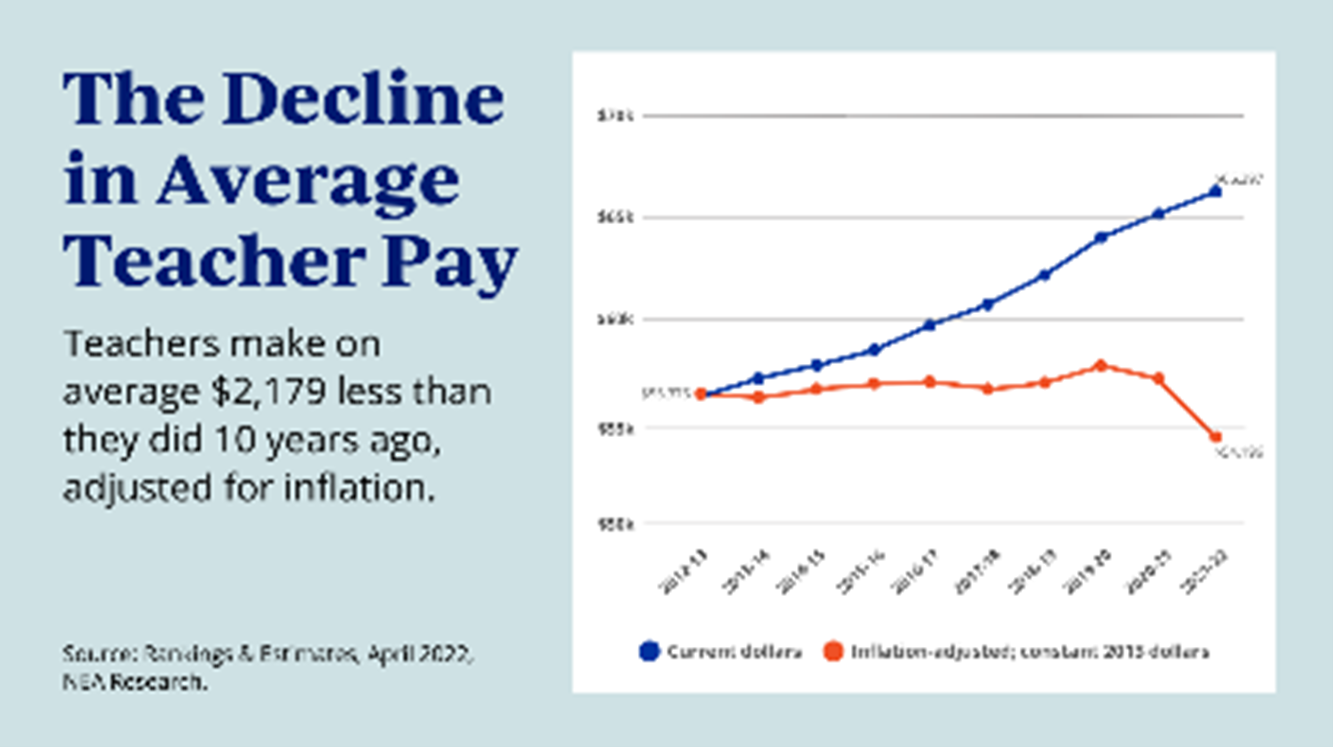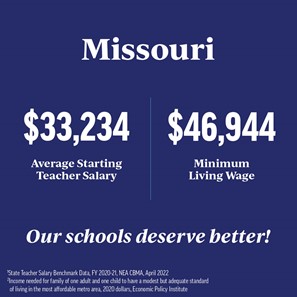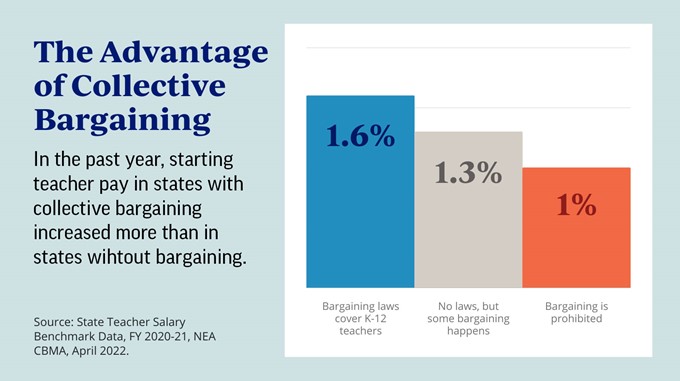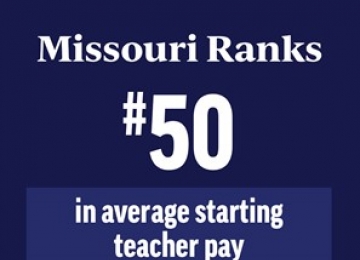The average national teacher salary is lower today than ten years ago, contributing to the national educator shortage.
On Tuesday, April 26, the National Education Association unveiled findings from four national reports on educator pay and school funding. The reports cover multiple topics including school staff wages and college faculty pay, as well as state spending on students. The reports paint a dire picture about the state of public education in America.
The big takeaway? Educator pay has failed to keep up with inflation. In fact, U.S, teachers today are making $2,179 less, on average, than they did 10 years ago.
 Throughout the ongoing pandemic, educators have gone above and beyond to make sure students receive the public education they deserve. In every community across the country, they are partnering with parents and families to ensure their students thrive. However, the looming teacher shortage crisis, fueled by low teacher pay and declining morale, as well as chronically underfunded public schools, is pushing educators to the brink. The crisis is preventing educators from given their students their best and the one-on-one attention they need. It’s forcing them to give up their class planning and lunch time to fill in for colleagues who are absent due to COVID. This trajectory is not sustainable.
Throughout the ongoing pandemic, educators have gone above and beyond to make sure students receive the public education they deserve. In every community across the country, they are partnering with parents and families to ensure their students thrive. However, the looming teacher shortage crisis, fueled by low teacher pay and declining morale, as well as chronically underfunded public schools, is pushing educators to the brink. The crisis is preventing educators from given their students their best and the one-on-one attention they need. It’s forcing them to give up their class planning and lunch time to fill in for colleagues who are absent due to COVID. This trajectory is not sustainable.
“For decades, America’s educators have been chronically underappreciated and shamefully underpaid,” said NEA President Becky Pringle. “Throughout this persistent and ongoing pandemic, they have demonstrated their commitment to all students, no matter their ZIP code, the language they speak, or the gender with which they identify. After persevering through the hardest school years in recent memory, our educators are exhausted and feeling less and less optimistic about their futures. If we want to reverse course and keep qualified teachers in the classroom and caring professionals in schools, then we must increase educator pay across the board and expand access to collective bargaining and union membership for all those working in public education,” said Pringle.
 If this nation is serious about tackling the educator shortage, part of the solution must include improving pay for teachers at all career stages and for the long term, rather than through one-time bonuses. State governments must appropriate funds to increase all educator salaries and this funding must come without a budgetary sleight of hand or gimmicks that require educators to jump through unnecessary hoops. Local school districts and colleges and universities must prioritize improving educators’ salaries, through spending down bulging cash reserves and using federal pandemic-relief monies, such as ARP funds, to provide the level of pay necessary to attract and retain educators. And all states must grant full collective bargaining rights to educators and other public-sector workers.
If this nation is serious about tackling the educator shortage, part of the solution must include improving pay for teachers at all career stages and for the long term, rather than through one-time bonuses. State governments must appropriate funds to increase all educator salaries and this funding must come without a budgetary sleight of hand or gimmicks that require educators to jump through unnecessary hoops. Local school districts and colleges and universities must prioritize improving educators’ salaries, through spending down bulging cash reserves and using federal pandemic-relief monies, such as ARP funds, to provide the level of pay necessary to attract and retain educators. And all states must grant full collective bargaining rights to educators and other public-sector workers.
The good news is that collective bargaining helps educators earn higher wages across the board. The NEA data shows that starting salaries for teachers rose by an average of 1.6 percent in states with a collective bargaining law. In states without such law, the pay increase falls to 1.0 percent. In addition, several states and localities are making significant strides to address educator pay problems. For example, Mississippi and New Mexico recently passed legislation authorizing historic pay increase for teachers.

The four NEA reports are:
-
Rankings and Estimates, which provides a wide array of school funding statistics and includes the average teacher salary by state and nationally.
-
Teacher Salary Benchmark Report, which provides information from nearly 12,000 school districts on average pay for new teachers, as well as additional career points.
-
ESP Earnings Report, which offers a breakdown of educational support professional (ESP) pay in K-12 and higher education.
-
Higher Education Faculty Salary Analysis, which looks at full-time faculty and graduate assistant salaries at the national, state, and institutional level.
For more NEA reports, please click here. This website also features an interactive map that shows where states rank on educator pay and student funding.
Missouri NEA Salary Research Reports can be found at www.mnea.org/research. These reports detail teacher pay in the Missouri school districts.
- Missouri Salary Benchmarks and Rankings 2021-2022
- Missouri Salary Rankings 2020-2021 (superintendents, teachers, administrators)
News Contact:
Mark Jones, MNEA communications director
(573) 644-9609


